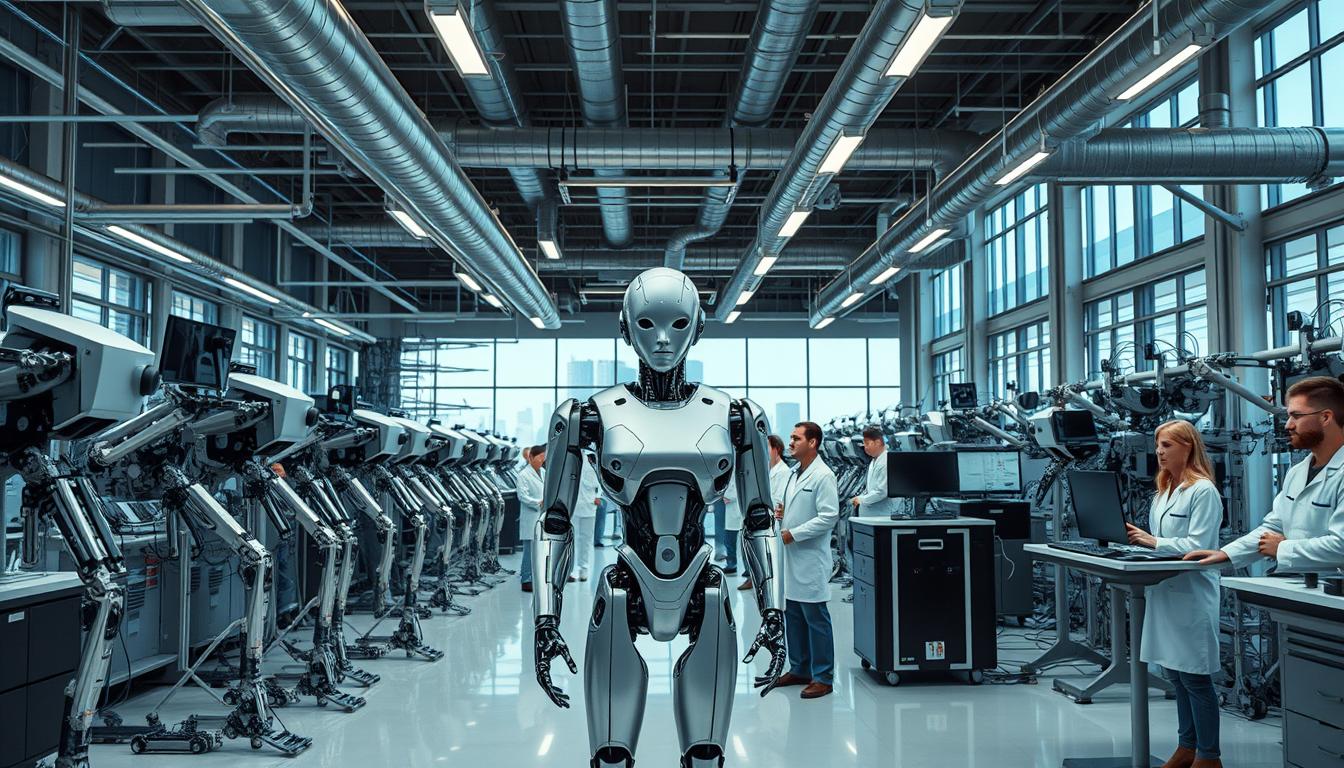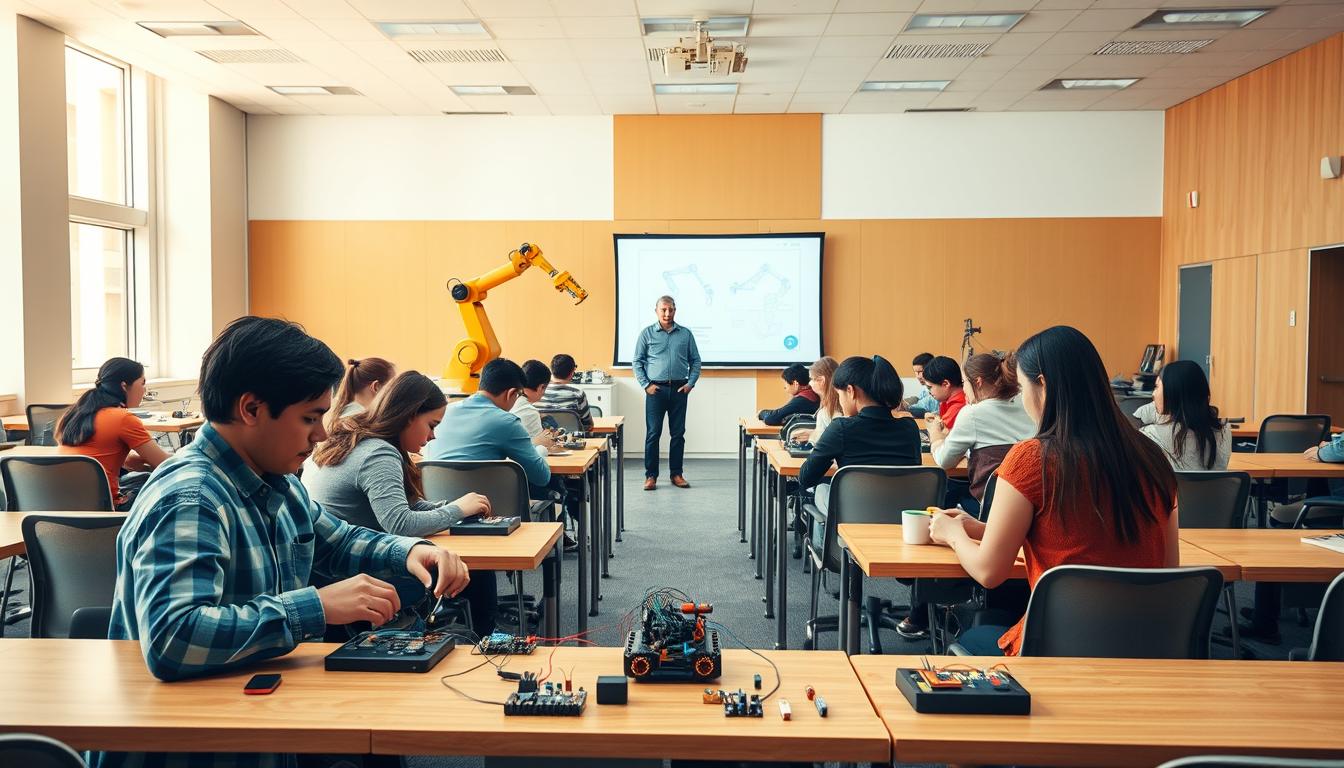

As we explore AI robotics, we find a world full of possibilities. AI has changed robotics engineering a lot. Now, we can make smarter and more independent machines.
Our AI engineering course teaches you what you need to know. It mixes mechanical, electrical, and computer science. This way, we can build robots that change industries all over the world.
Key Takeaways
- Understanding the principles of AI and robotics
- Learning to design and construct robots with AI integration
- Gaining knowledge of mechanical, electrical, and computer science principles
- Developing skills to operate and maintain AI-powered robots
- Exploring the applications of AI robotics in various industries
The Convergence of AI and Robotics in Modern Engineering
The mix of AI and robotics is changing engineering. It’s not just a new tech; it’s a big change that’s changing industries and work’s future.
The Evolution of Robotics Engineering
Robotics engineering has grown a lot, from simple machines to complex ones. AI has been a big help, making robots smarter and more independent.
How AI Has Transformed Traditional Robotics
AI has changed robotics by adding machine learning and more. Robots can now learn from their surroundings and handle new tasks better.
Current Industry Trends and Future Projections
AI robots are becoming more common in fields like manufacturing and healthcare. It’s expected that AI and robotics will keep growing, shaping industry futures. We’ll see more robots working together and AI combining with IoT and blockchain.
What to Expect from an AI Robotics Engineering Course
Exploring the AI Robotics Engineering Course, it’s key to know what’s in store. Our program aims to give you a solid education. You’ll learn both the theory and practical skills needed in AI and robotics.
Core Components of the Curriculum
The course covers vital topics like AI algorithms, machine learning, and robotics programming. You’ll dive into the basics of artificial intelligence and robotics. This includes AI algorithms and machine learning techniques. It’s all about building a strong foundation in both theory and practice.
Technical Skills You’ll Develop
You’ll learn programming languages like Python, C++, and ROS. These skills are essential for a career in AI robotics engineering. You’ll apply these skills to solve real-world problems, improving your ability to design and develop AI robots.
Balancing Theoretical Knowledge with Practical Application
Our course focuses on balancing theory and practice. You’ll work on projects that link theoretical concepts to real-world issues. This hands-on experience is key to understanding AI robotics deeply.
Typical Course Duration and Time Commitment
The course length and time needed can vary. A full AI robotics engineering course might last from months to years. Here’s a quick overview:
| Course Type | Duration | Time Commitment |
|---|---|---|
| Certificate Course | 3-6 months | 10-15 hours/week |
| Diploma Course | 6-12 months | 15-20 hours/week |
| Degree Program | 2-4 years | Full-time |
Knowing the course length and time needed helps you plan your studies better.
Types of AI Robotics Engineering Courses Available
The field of AI robotics engineering is growing fast. Now, there are many ways to learn and start a career in this field.
There are several paths for those wanting to work in AI robotics engineering. These include:
University Degree Programs
University degree programs in AI robotics engineering give a deep education. They cover both the theory and how to apply it. These programs aim to give a wide understanding of the field.
Professional Certification Courses
For those wanting to improve their skills or switch careers, certification courses are a good choice. They are shorter and more focused than degree programs.
Online Learning Platforms and MOOCs
Online learning platforms and MOOCs (Massive Open Online Courses) let you learn from anywhere. They offer flexibility and include courses from top universities.
Bootcamps and Intensive Programs
Bootcamps and intensive programs focus on hands-on learning. They are great for those who like learning through projects. These programs help you get ready for the job market quickly.
Knowing about the different AI robotics engineering courses helps you choose the right path. This way, you can make a smart decision for your education and career.
How to Choose the Right AI Robotics Engineering Course

There are many AI robotics engineering courses out there. Choosing the right one for your goals and skill level is key. This choice affects your career and the skills you gain.
Assessing Your Current Skill Level
First, check your skills in AI and robotics. Look at your programming, math, and engineering knowledge. Knowing your strengths and weaknesses helps pick the right course.
Identifying Your Career Goals
Next, think about your career goals. Do you want a new job or improve your current one? Courses vary by career path. For example, research roles might need advanced courses.
Evaluating Course Accreditation and Recognition
Check if the course is accredited. Make sure it’s recognized by a good accrediting agency. This affects how employers see your degree. Look at the course’s reputation and past students’ feedback.
Comparing Cost vs. Value Propositions
Lastly, weigh the course’s cost against its value. Cost matters, but it’s not everything. Think about the course’s content, instructor quality, and hands-on experience. A pricier course might be worth it for better resources and teaching.
| Course Feature | Course A | Course B | Course C |
|---|---|---|---|
| Accreditation Status | Accredited | Not Accredited | Accredited |
| Cost | $5,000 | $3,000 | $4,000 |
| Practical Experience Opportunities | Yes | No | Yes |
| Instructor Expertise | High | Medium | High |
Essential Prerequisites for Success in AI Robotics
AI robotics needs a solid base in key areas. To do well, you must know the basics.
Mathematical Foundations You Need
A strong math background is key for AI robotics. You’ll need linear algebra, calculus, and probability theory. These math areas are the foundation of AI and robotics.
Programming Languages to Master
Knowing certain programming languages is crucial. Python is popular because it’s easy to use and has lots of libraries like TensorFlow and PyTorch. C++ and Java are also important for robotics.
Basic Engineering Concepts to Understand
It’s important to know basic engineering like mechanics, electronics, and control systems. These basics help in designing and building robots that can interact and adapt.
Self-Assessment Tools and Preparatory Resources
Using self-assessment tools and resources is helpful before a course in AI robotics. Online courses, textbooks, and practice problems can check your readiness and improve weak areas.
| Prerequisite | Description | Importance Level |
|---|---|---|
| Mathematical Foundations | Linear algebra, calculus, probability theory | High |
| Programming Languages | Python, C++, Java | High |
| Basic Engineering Concepts | Mechanics, electronics, control systems | Medium |
| Self-Assessment Tools | Online courses, textbooks, practice problems | Medium |
Step-by-Step Guide to Enrolling in an AI Robotics Engineering Course

Signing up for an AI robotics engineering course is a big step towards a career in this fast-growing field. We must think about several important steps as we go through this process.
Researching and Shortlisting Potential Programs
The first thing to do is to look for available programs. We should find courses that teach both the theory and practical use of AI robotics. It’s crucial to check the curriculum, faculty expertise, and any industry connections the program might have. According to Dr. Jane Smith, a leading expert in AI robotics, “The right program can make all the difference in preparing you for a successful career.”
We can find information on university websites, online course platforms, and educational forums. Making a list of potential programs helps us compare their strengths and weaknesses.
Navigating the Application Process
After picking potential programs, we need to go through their application processes. This usually means sending in academic transcripts, letters of recommendation, and a personal statement. We should make sure our application is detailed and shows off our relevant skills and experiences.
As
“The application process is not just about fulfilling the requirements; it’s about showcasing your passion and potential in the field,”
notes
Mark Johnson, Director of Admissions at a top engineering university
. So, we must tailor our application to show our dedication to AI robotics.
Securing Financial Aid and Scholarships
Getting financial aid or scholarships is key for many students. We should look into government grants, university scholarships, and private funding sources.
It’s important to check the eligibility criteria and application deadlines for each option. We should also understand the terms and conditions of any financial aid, like repayment or academic performance expectations.
Preparing for Entrance Exams or Interviews
Some programs might need entrance exams or interviews. We need to prepare well for these, reviewing important material and practicing common interview questions. Preparation is key to making a strong impression.
By following these steps, we can successfully enroll in an AI robotics engineering course. This is a big step towards a fulfilling career in this field.
Maximizing Your Learning in an AI Robotics Engineering Course
To get the most out of an AI robotics engineering course, we need to manage our time well. We should also use all the resources available and talk to our instructors and mentors. A structured plan is key to success.
First, we must make a study schedule that works. This means planning our study time, setting achievable goals, and making sure we have enough time for both theory and practice. A good schedule helps us stay focused, manage our time, and avoid cramming.
Creating an Effective Study Schedule
To make a good study schedule, we should first look at our commitments and how much time we have to study. Then, we can set aside specific times for studying, reviewing, and practicing. It’s important to include breaks and time to relax to avoid getting too tired.
Utilizing Available Resources and Tools
Using all the resources and tools we can is crucial. This includes online materials, software, and other course resources. We should also look for extra resources like tutorials, research papers, and industry publications to learn more about AI robotics engineering.
Forming Study Groups and Collaborative Networks
Joining study groups and networks can really help our learning. Working with others lets us share knowledge, discuss tough topics, and learn from each other. It also helps us improve our teamwork and communication skills.
Engaging with Instructors and Industry Mentors
Talking to our instructors and mentors is also very important. They can give us valuable insights, advice, and feedback. We should use office hours, ask questions, and seek their advice to deepen our understanding.
By following these steps, we can make the most of our AI robotics engineering course. We’ll be able to reach our goals and learn a lot.
Overcoming Common Challenges in AI Robotics Education
AI robotics education comes with its own set of challenges. These include technical issues, complex concepts, and keeping up with new tech. Each one can slow us down.
Troubleshooting Technical Difficulties
Technical problems can really hold us back. To fix them, we should use online forums, documentation, and tech support. Keeping our tools and software up to date can also help avoid many issues.
Managing Complex Concepts and Information Overload
Handling complex ideas needs a clear plan. We can break them down into smaller parts. Study groups also help by making learning a team effort.
Keeping Up with Rapid Technological Changes
To keep up with new tech, we should read industry news, go to webinars, and join conferences. This way, we can stay current and adapt quickly.
Balancing Course Work with Other Commitments
Managing our time is key when balancing school with other things. A good study schedule helps us stay on track.
Hands-On Projects to Enhance Your Learning Experience
Our AI Robotics Engineering Course focuses on hands-on projects. These projects give you the practical skills needed to succeed. You’ll apply what you learn to real problems, deepening your understanding and skills.
Building Your First AI-Powered Robot
Start by building your first AI-powered robot. This project teaches you the basics of robotics and AI. You’ll learn about sensors, motors, and programming.
You’ll design, assemble, and program your robot. This lays the groundwork for more advanced projects.
- Understand the basics of robotics and AI
- Learn to design and assemble robotic components
- Develop programming skills using relevant languages
Intermediate Projects for Skill Development
Next, you’ll tackle more challenging projects. These might include robotic arms, navigation systems, or AI for object recognition.
- Develop a robotic arm capable of performing specific tasks
- Create a navigation system for an autonomous robot
- Implement AI algorithms for object detection and recognition
Advanced Capstone Project Ideas
The capstone project is the final step. You’ll design and implement an advanced AI robotics project. Ideas include autonomous delivery systems, robotic companions, or smart home automation.
Some potential capstone project ideas include:
| Project Idea | Description | Skills Developed |
|---|---|---|
| Autonomous Delivery System | Design a robot that can navigate and deliver items autonomously | Navigation, AI, Robotics |
| Robotic Companion | Create a robot that can interact with humans in a meaningful way | AI, Human-Robot Interaction |
| Smart Home Automation | Develop a system that automates home appliances using AI and robotics | AI, IoT, Robotics |
Documenting Your Work for a Professional Portfolio
It’s important to document your projects. This helps show your skills to employers. We teach you how to write reports, make videos, and maintain an online presence.
By doing these projects and documenting them, you’ll gain valuable experience. You’ll also build a strong portfolio that showcases your AI robotics skills.
Career Opportunities After Completing an AI Robotics Engineering Course
After finishing an AI robotics engineering course, you’ll find many career opportunities in new industries. The field of AI robotics is growing fast. There’s a big need for skilled engineers.
In-Demand Roles in the Industry
AI robotics engineering graduates can get into many in-demand roles. Jobs like AI/ML engineer, robotics engineer, and data scientist are key. They help make and use AI and robotics in many areas.
Other roles like robotics software engineer and AI research scientist are also important. These jobs need a good base in AI and robotics. Plus, you need to know how to use the latest tools and technologies.
Salary Expectations and Growth Potential
Salary expectations for AI robotics engineers are high. Salaries can be from $80,000 to over $150,000. This depends on where you work, how long you’ve been working, and your job title.
The growth potential in this field is big. You can move up to senior roles, manage projects, or even start your own business. Keeping up with new tech is important for moving forward in your career.
Industries Actively Hiring AI Robotics Engineers
AI robotics engineers are wanted in many fields. Industries like manufacturing, healthcare, and logistics are looking for them. They use AI and robotics to work better, save money, and create new products.
Other fields like retail, agriculture, and security are also starting to use AI robotics. As these technologies get better, we’ll see them used in even more areas.
Networking Strategies for Job Placement
Good networking strategies are key to finding jobs in AI robotics. Go to industry events, join groups, and use online forums. This helps you meet people in the field.
Make connections through LinkedIn or at hackathons. Keep your portfolio up to date. This shows your skills to employers.
Conclusion: Embarking on Your AI Robotics Journey
Starting your AI robotics journey needs dedication, hard work, and a love for innovation. We’ve looked at the AI robotics engineering course. Now, we urge you to start your journey in this exciting field.
With the skills and knowledge from such a course, you’re ready for the fast-changing AI robotics world. We’ve talked about AI and robotics, the different courses, and the jobs waiting for you.
Remember, AI robotics is always changing. Keeping up with new trends and tech is key to your success. Keep learning, trying new things, and exploring what AI robotics can do.
Your AI robotics journey is just starting, and the future is bright. With hard work and the right training, you can reach your goals and make a big difference in this field.
FAQ
What is the typical duration of an AI robotics engineering course?
Course length varies. It can be a few months for certifications or several years for degrees.
What programming languages are used in AI robotics engineering?
We use Python, C++, and ROS. These languages help develop AI robotics skills.
What are the prerequisites for enrolling in an AI robotics engineering course?
You need to know math, programming, and basic engineering. This foundation is key.
How do I choose the right AI robotics engineering course for my career goals?
First, check your current skills and career aims. Look at course accreditation and cost. Compare these to find the best fit.
What kind of projects can I expect to work on in an AI robotics engineering course?
You’ll do hands-on projects. This includes building AI robots, improving skills, and working on advanced projects.
What are the career opportunities after completing an AI robotics engineering course?
You’ll find jobs in many fields. Expect good pay and chances for growth.
How can I maximize my learning in an AI robotics engineering course?
Make a study plan and use resources. Join groups and talk to instructors and mentors. This helps a lot.
What are the common challenges in AI robotics education, and how can I overcome them?
You might face tech issues, complex concepts, and keeping up with new tech. Stay organized and ask for help.
Are there any financial aid or scholarships available for AI robotics engineering courses?
Yes, we help find financial aid and scholarships. This makes education more affordable.
How can I network and find job opportunities after completing an AI robotics engineering course?
We teach networking for jobs. Use industry connections to find your next career step.
RELATED POSTS
View all


